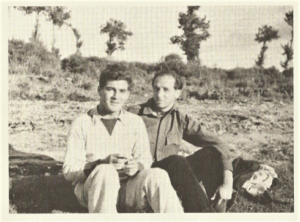On September 27, 28, and 29, Music Director Andrés Orozco-Estrada presents Gershwin’s Piano Concerto & Porgy and Bess, a concert of 20th-century masterpieces from the Western hemisphere. In this post, discover how Aaron Copland’s visit to Mexico led the composer in a whole new direction. Learn more and get tickets.

Eager to entice his friend and fellow composer to visit Mexico, Carlos Chávez made Aaron Copland a tempting offer in 1932: an all-Copland concert at the National Conservatory. Copland took the bait. Together with his boyfriend, a violinist by the name of Victor Kraft, Copland drove from New York to San Antonio, where they boarded a train for Mexico City.
Copland’s interest in Mexico, however, went beyond the opportunity of hearing his works performed. With its vibrant new artistic life, Copland was eager to see post-revolutionary Mexico with his own eyes. He was not disappointed. “Mexico has turned out even grander than I expected, and I expected pretty grand things. The best is the people,” he wrote in a letter to a friend. Copland and Kraft would stay for four months.
El Salón México
One place in particular captured the composer’s imagination: El Salón México. A contemporary guide book described it as a “Harlem type night-club” with “three halls: one for people dressed in your way, one for people dressed in overalls but shod, and one for the barefoot.” Copland noted that the book failed to mention “a guard stationed at the bottom of the steps leading to the ‘three halls’ [who] would nonchalantly frisk you as you started up the stairs just to be sure you had checked all your ‘artillery’ at the door.” He fell in love with the establishment, staying until closing at 5 a.m. on at least one occasion.
Copland soon resolved to write a piece about the Salón. “It wasn’t the music that I heard there, or the dances that attracted me, so much as the spirit of the place,” Copland continued, and indeed, for inspiration he drew not on the popular dance music he heard at El Salón, but on traditional Mexican folk songs. The piece would deconstruct and reassemble these melodies through a sophisticated, collage-like technique, creating a modern portrait of contemporary Mexico as seen through Copland’s eyes.
Copland’s New Sound
Stylistically, El Salón marked a turning point for Copland, who had studied in Paris and previously explored the various trends of the European avant-garde in his music. Like many left-leaning artists and intellectuals, Copland became increasingly concerned with the artist’s relationship to society during the Great Depression; he wanted to write music for “the people” that would make use of the many innovations of modern music while still remaining accessible to ordinary listeners. Furthermore, he wanted to write music that was distinctly American.
El Salón México would be among his first and most successful works in this new, populist style. Throughout, Copland orchestrates with pure, crisp colors, and the music is characterized by bold, clear melodic lines, almost as if he were composing a musical analogue to Diego Rivera’s murals. It would take years for this piece to reach its first performance, however. “This composition celebrating Mexico was completed, strangely enough, in Bemidji, Minnesota, 250 miles north of Minneapolis, where I spent the summer of 1934,” Copland noted. The piece would prove successful with musicians, audiences, and critics alike and remains one of Copland’s most popular works. He dedicated it to Kraft.
The Music
The work begins with attention-grabbing, upward-thrusting motifs based on fragments of the folk tune “El Palo Verde.”
This soon dies away to a slow and playfully off-kilter and out of tune oom-pah accompaniment from the trombone and bassoons, perhaps imitating an old barrel organ. Above this, a trumpet and clarinet trade off with a floridly embellished melody. The dance gets going as timpani, piano, and double basses outline a rhythmic pattern, above which bass clarinet and bassoon introduce another traditional melody, “El Mosco.” A series of melodies, some piquant, others sentimental, pass through the orchestra as the tempo accelerates, building to a powerful, halting return of “El Palo Verde.”
The music then slows, and the cycle begins again. A clarinet begins a new melody above a chamber music accompaniment, and woodwinds mingle waltz-like corridos. These dreamy waltzes gradually give way to more lively music, including a cheeky solo for E-flat clarinet. The music becomes faster and faster, leading to a thrilling conclusion.
Copland put his final touches on the piece in 1936, and Carlos Chávez led the premiere with the Orquesta Sinfónica de Mexico in 1937. “To the customary misgivings any composer has at the thought of a premiere there was added my natural fear as to what the Mexicans might think of a ‘gringo’ meddling with their native melodies,” Copland recalled. “As I entered the rehearsal hall, the orchestral players […] suddenly stopped what they were doing, and began to applaud vigorously. […] I shall always remember that gesture. It instantaneously made the writing of El Salón México worthwhile, at least as far as I was concerned.”
Don’t miss Copland’s El Salón México at Gershwin’s Piano Concerto & Porgy and Bess September 27, 28, and 29! Learn more and get tickets.



